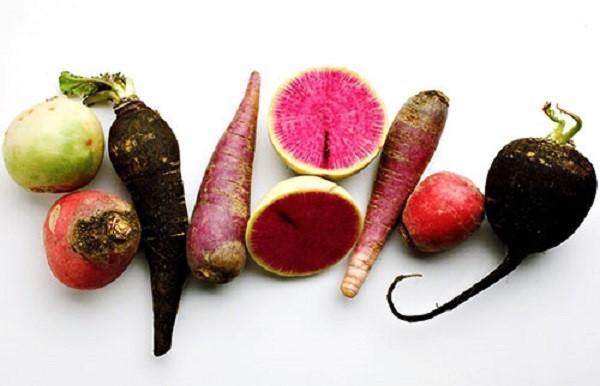Varieties of radish or how to choose the right delicious root vegetable
 It has long been known that radish is not only tasty, but also very useful, therefore it is recommended to include it in the daily diet. No one will argue that the best quality vegetables grow in their own garden. However, not everyone has the opportunity to grow radishes on their own, for example, residents of megacities go to markets or shops in search of a vitamin.
It has long been known that radish is not only tasty, but also very useful, therefore it is recommended to include it in the daily diet. No one will argue that the best quality vegetables grow in their own garden. However, not everyone has the opportunity to grow radishes on their own, for example, residents of megacities go to markets or shops in search of a vitamin.
How not to be mistaken so that instead of juicy root vegetables you don't get tough, tasteless and practically useless vegetables? Let's deal with this issue together. But first of all, it is worth remembering what types of radish are, because depending on this, the choice of the buyer is determined: someone just wants to crunch a vitamin salad, while others need it as a medicine.
Types of radish
All varieties of radish contain the same complex of nutrients, such as:
- vitamins B and C;
- flavonoids;
- mineral salts;
- cellulose;
- amino acids and others.
The types of root vegetables differ in the concentration of these same vitamins.
The most useful radish is black, it contains the most useful substances. But in white radish, the vitamin ratio is the lowest, so it is not almost used for medicinal purposes.
Most often these types of radish are grown:
- Green... The top is covered with a light green peel, and the inside is juicy, tasty and not bitter red flesh. It contains a large amount of mineral salts, sugars and fiber.
- White... It has white juicy pulp with medium sharpness. Outside, the skin is also white, but with a green tinge at the site of cuttings growth. Contains a lot of coarse dietary fiber.
- Black... Under the black skin lies a snow-white pulp, juicy but very bitter. This taste is the result of the increased content of mustard oil glycosides and phytoncides.
- Daikon... It looks like a large white carrot, the pulp is sweet, juicy. Due to the fact that it contains no mustard oils, there is no bitterness either, but there is a lot of iodine, iron, calcium, magnesium.
- Radish... Small, round or elongated roots with white flesh and red skin have a slight bitterness.
What should you look for when buying a radish?
In order for the beneficial properties and taste to be preserved, the radish must be properly grown, and the harvest must be harvested on time. Whether this is true or not, it will help to understand the appearance of the root crop itself:
- too large or soft radish indicates that it has been in the garden for a long time and is overripe;
- small fruits can be the result of thickening of plantings or early harvesting.
There are not enough vitamins in large and small root crops, the most useful and vitamin radish should be the size of one and a half fists. As for the daikon, its optimal size is like a large carrot.
The fact that the radish is fresh can also be determined by its appearance. The main features of a fresh and quality vegetable are:
- no damage to the skin surface;
- firm pulp structure;
- green and crispy ponytail.
So that the radish in the salad is not so bitter, you need to pour it with water several times and let it stand for a little so that the bitterness comes out. All useful substances will remain.